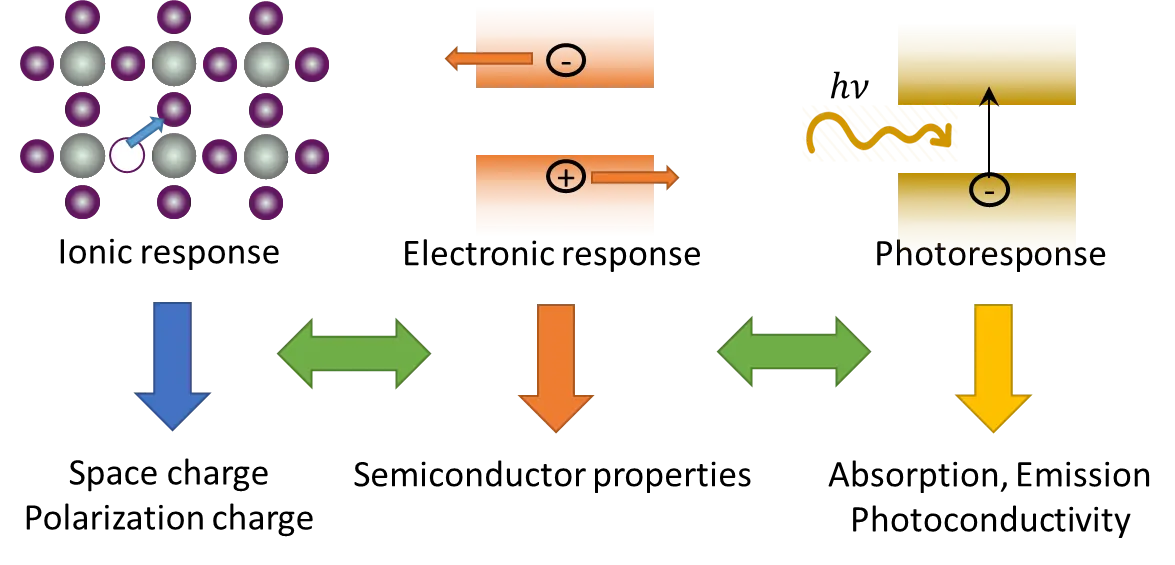Defect Engineering, Advanced Modelling and Characterization for Next Generation Opto-Electronic-Ionic Devices

At a glance
- Project leader : Dr. Wolfgang Tress
- Deputy of project leader : Prof. Dr. Beat Ruhstaller
- Project team : Dr. Firouzeh Ebadi Garjan, Mahdi Mohammadi, Miguel Angel Torre Cachafeiro, Oliver Zbinden
- Project budget : EUR 1'980'000
- Project status : ongoing
- Funding partner : EU and other international programmes (European Research Council ERC / Starting Grant)
- Contact person : Wolfgang Tress
Description
In the project Defect Engineering, Advanced Modelling and
Characterization for Next Generation Opto-Electronic-Ionic Devices
(OptEIon), we investigate the interplay between electron and ionic
conductivity in metal-halide perovskite semiconductors. We plan to
prepare samples, characterize the transient optoelectronic
response, and employ device modelling to unravel the effects of
electronic and ionic defects. Finally, we aim to exploit the mixed
ionic-electronic conductivity in novel devices.
Perovskite solar cells have attracted grain interest because of the
high efficiencies obtained (>25%) and facile preparation
methods. Key to these impressive results is the high tolerance of
the perovskite semiconductor versus defects. On the other hand,
perovskite solar cells and LEDs suffer from instabilities,
partially due to mobile ionic charges. These ions originate from
crystal defects (e.g. vacancies as shown on the top left in the
figure). Beyond being a stability concern, mobile ions influence
the optoelectronic response of the device, e.g. by drift when a
voltage is applied. This causes a belayed response that is visible,
e.g. in a hysteresis when recording the current-voltage
characteristics or in unconventional features in the impedance
response.
Within this project, we intend to further characterize the
interplay between ionic and electronic conductivity. We plan to
fabricate perovskite films, characterize their response to voltage
and illumination stimuli and use device simulation to extract
physical parameters. To gain insights into nanoscopic processes, we
plan to use tipenhanced spectroscopy techniques. On the simulation
side, we want to evaluate, whether and to which extent
physics-based modeling can be complemented by approaches based on
machine learning.
The goal of this project is to control the effect of mobile ions
and exploit them as modulator of loss processes in solar cells or
in novel devices. A potential candidate are memristive devices. In
such devices the conductivity depends on the history of the device,
for instance on how much current was passed through it in the time
before. Such devices might become interesting for future computing
approaches such as neuromorphic computing.
Publications
-
Feng, Shien-Ping; Cheng, Yuanhang; Yip, Hin-Lap; Zhong, Yufei; Fong, Patrick W.K.; Li, Gang; Ng, Annie; Chen, Cong; Castriotta, Luigi Angelo; Matteocci, Fabio; Vesce, Luigi; Saranin, Danila; Carlo, Aldo Di; Wang, Puqun; Wei Ho, Jian; Hou, Yi; Lin, Fen; Aberle, Armin G.; Song, Zhaoning; Yan, Yanfa; Chen, Xu; Yang, Yang (Michael); Syed, Ali Asgher; Ahmad, Ishaq; Leung, Tiklun; Wang, Yantao; Lin, JingYang; Ng, Alan Man Ching; Li, Yin; Ebadi Garjan, Firouzeh; Tress, Wolfgang; Richardson, Giles; Ge, Chuangye; Hu, Hanlin; Karimipour, Masoud; Baumann, Fanny; Tabah, Kenedy; Pereyra, Carlos; Raga, Sonia R.; Xie, Haibing; Lira-Cantu, Monica; Khenkin, Mark V.; Visoly-Fisher, Iris; Katz, Eugene A.; Vaynzof, Yana; Vidal, Rosario; Yu, Guicheng; Lin, Haoran; Weng, Shuchen; Wang, Shifeng; Djurišić, Aleksandra B.,
2023.
Roadmap on commercialization of metal halide perovskite photovoltaics.
Journal of Physics: Materials.
6(3), pp. 032501.
Available from: https://doi.org/10.1088/2515-7639/acc893
-
2022.
Mixed ionic electronic conductivity in metal halide perovskites and its effects on solar cells.
In:
ATHENA Intensive Course in Metal Halide Perovskites: From Materials to Applications, online, 7-10 November 2022.
-
Mohammadi, Mahdi; Ebadi Garjan, Firouzeh; Tress, Wolfgang,
2022.
Performance boosting polymeric finish layer for perovskite solar cells.
In:
8th International Conference on Simulation of Organic Electronics and Photovoltaics (SimOEP), Winterthur, Switzerland, 7-9 September 2022.
-
Torre Cachafeiro, Miguel Angel; Kumar Kumawat, Naresh; Gao, Feng; Tress, Wolfgang,
2022.
Simulating the transient luminescence of perovskite light-emitting diodes under pulsed operation.
In:
8th International Conference on Simulation of Organic Electronics and Photovoltaics (SimOEP), Winterthur, Switzerland, 7-9 September 2022.
-
2022.
Device physics of perovskite solar cells.
In:
International Conference on Photovoltaic Science and Technologies (PVCON), Hatay, Turkey, 5-7 July 2022.
-
Sirtl, Maximilian T.; Hooijer, Rik; Armer, Melina; Ebadi Garjan, Firouzeh; Mohammadi, Mahdi; Maheu, Clément; Weis, Andreas; van Gorkom, Bas T.; Häringer, Sebastian; Janssen, René A. J.; Mayer, Thomas; Dyakonov, Vladimir; Tress, Wolfgang; Bein, Thomas,
2022.
Advanced Energy Materials.
12(7), pp. 2103215.
Available from: https://doi.org/10.1002/aenm.202103215
-
2021.
Characterizing perovskite solar cells and LEDs..
In:
ICAMD21, Korea (online), 6-9 December 2021.
-
2021.
In:
XVII encuentro de fisica, online, Quito, Ecuador, 25-29 October 2021.
-
2021.
Physics of perovskite optoelectronic devices.
In:
nanoGe Fall Meeting, online, 18-22 October 2021.
-
Ebadi Garjan, Firouzeh; Yang, Bowen; Tress, Wolfgang,
2021.
In-Operando PL measurements on perovskite solar cells with and without phase-segregation.
In:
38th European Photovoltaic Solar Energy Conference and Exhibition (EUPVSEC), online, 6-10 September 2021.
-
Sirtl, Maximilian T.; Ebadi, Firouzeh; van Gorkom, Bas T.; Ganswindt, Patrick; Janssen, René A. J.; Bein, Thomas; Tress, Wolfgang,
2021.
The bottlenecks of Cs2AgBiBr6 solar cells : how contacts and slow transients limit the performance.
Advanced Optical Materials.
9(14), pp. 2100202.
Available from: https://doi.org/10.1002/adom.202100202
-
Ebadi Garjan, Firouzeh; Yang, Bowen; Kim, YeonJu; Mohammadpour, Raheleh; Taghavinia, Nima; Hagfeldt, Anders; Tress, Wolfgang,
2021.
Journal of Materials Chemistry A.
9(24), pp. 13967-13978.
Available from: https://doi.org/10.1039/D1TA02878B
-
2021.
The various effects of ion migration on perovskite devices.
In:
HOPV21, online, 24-28 May 2021.
-
Tress, Wolfgang; Sirtl, Maximilian T.,
2021.
Cs2AgBiBr6Double perovskites as lead‐free alternatives for perovskite solar cells?.
Solar RRL.
Available from: https://doi.org/10.1002/solr.202100770
-
Kumawat, Naresh Kumar; Tress, Wolfgang; Gao, Feng,
2021.
Nature Communications.
12(4899).
Available from: https://doi.org/10.1038/s41467-021-25016-5
-
2020.
Device physics of perovskite solar cells.
In:
8th International Conference on Nanostructures (ICNS8), Tehran, Iran, 18-20 November 2020.